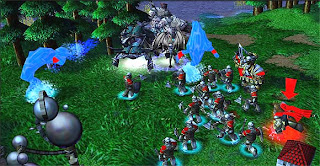Trending
Opinion: How will Project 2025 impact game developers?
The Heritage Foundation's manifesto for the possible next administration could do great harm to many, including large portions of the game development community.

Featured Blog | This community-written post highlights the best of what the game industry has to offer. Read more like it on the Game Developer Blogs or learn how to Submit Your Own Blog Post
Are exploits really so bad? Is iteration just a tool for fixing problems, or can it help us find new solutions? I examine these questions by taking a look at the exploits of Warcraft III alongside the ever elusive phenomenon of the "Ascended Glitch".


Of Bugs and Features Obscura
Developers often use the phrase as a joke for when some outlandishly bizarre yet hilarious bug pops up in their game. Coming from a software development lineage, bugs are often seen as bad things, and in sports any kind of exploit or funny attempt to bend the rules is generally frowned upon. I would argue games are different, and that sometimes bugs and exploits can become wonderful things.
Perhaps my fondest memories involving exploits come from back when I was really into Warcraft III: Reign of Chaos. It was the first game I had followed since beta, and thus had a chance to watch grow and evolve over countless patches and updates. Along the way players came up with some clever and often hilarious ways to mess with the game's mechanics.
In searching around to refresh my memory on a few of these exploits, I came to discover that it seems like they have mostly been forgotten from the internet. No videos, no articles, not even a wiki detailing these early exploits and the antics that ensued. I felt much like the last living practitioner of the ancient Vedic Sikh [EDIT 4/9/12] martial art of Shastar Vidya, and that I alone carried a forgotten secret that I am morally compelled to share with the world, that it's knowledge may live on forever. So let's get started.
The Glory Days of RoC
While an awesome game in its own right, Warcraft III did get off to a bumpy start. Over the first few years of its life it received numerous patches, ranging from minor balance fixes to major overhauls of major systems in the game. This was all done in the name of tuning the balance of what was in many ways a very different kind of RTS.
The game changed most dramatically upon the release of its expansion, The Frozen Throne, where the entire armor system was redone and invisibility detection for heroes was reworked (notably by replacing the passive gem of revealing for the limited duration, activated dust of appearance) among many other big changes.
Over the course of this process of refinement, players were able to find clever ways to exploit the game to do some pretty outlandish strategies. Below are a few examples of some of the more notable ones.
Note: Sadly these mostly existed in the pre-youtube dark ages of the internet, so I've taken some liberties with visual representations.
Forest Walking
Undead have a different way of gathering resources compared to other races. Whereas most races have a single builder unit that doubles as a resource gatherer, the Undead used two different units for this purpose: Acolytes, for gathering gold and summoning structures (in the same manner as the Protoss probes in Starcraft), and Ghouls, which harvest lumber and are also your tier 1 melee unit. Ghouls aren't amazingly powerful, but can be deadly in groups, especially with a Dread Lord and/or Death Knight's auras on them (the former giving life steal, the latter faster health regeneration and move speed). Think of them like the zerglings of Warcraft III.
A noteworthy behavior to point out about resource gathering units is that while they are harvesting lumber or gold, their unit collision is turned off (ie they walk right through any other unit). Ordinarily, this is meant to prevent workers from getting in the way of your units and vice versa, but one clever Korean player (as the legend goes) discovered that you could use this to your advantage in battle.
Say you are up against some Humans as Undead, and they are charging at you, with some trees behind them. What you could do is select your ghouls, then click on the trees behind them, commanding the ghouls to harvest from them. This would then cause your ghouls to walk toward that tree and walk right through your opponent's army. Once they have surrounded the enemy hero, you could then order them to focus fire on him, forcing them to use a pricy town portal scroll to teleport his army back to base, or stand there and die. Since losing a hero in battle can make a huge difference, this could make for an easy win for an unscrupulous Undead player.
While this exploit was patched away, it still exists in some form in Starcraft 2. Skilled zerg players are able to command groups of zerglings, which are both small and among the fastest units in the game, to move past a cluster of enemy units, then command them to stop, which immediately causes them to attack nearby enemies, thus trapping them and in most cases sealing their fate. It can make a huge difference in how much damage your zerglings will inflict.
Militia Rushing
Every race has a unique way of defending their base, particularly against early harassment. For Orcs, they have burrows, which act as bunkers for their peons to get into to throw spears at nearby enemies. Night Elves have moon wells, which heal and recover the mana of nearby units. Undead can convert their ziggurats into towers and (after Frozen Throne) could use an item from their racial shop to summon skeletons from their graveyard building. Humans could temporarily turn their peasants into militia, combat units roughly on par with Footmen, but only lasted for 30 seconds until reverting back to peasants.
While designed to help defend bases and expansions from attacks, someone also discovered it could be used offensively as well. If you build a Town Hall near an opponent's base when they aren't looking, you could amass a large group of peasants quickly, convert them to militia, and overwhelm your opponent with sheer numbers.
This strategy is similar to a cheesy move that can be done as Zerg in Starcraft 2. Known as the Proxy Hatch, Zerg players can theoretically build a hatchery inside an opponent's natural* and create a flood of units to overwhelm their opponent from behind their wall of defenses.
*Note: "Natural" refers to the valley or peninsula a player starts at, which typically has a single entrance. This is in contrast to "expansions," or other areas on the map where a base could be established to harvest resources.
The Cube
In the early Warcraft III days, heroes were able to gain experience whenever a tower kills a unit. On the surface this seems sensible, but of course some players took it upon themselves to exploit this fact. Afterall, if towers can award kills, who needs units? Thus "The Cube" strategy was born.
The Cube was created by creating a massive square (or "cube") of towers in the middle of the map and focusing only on making three heroes and almost no other units. This was typically done as the humans, as they had the most types of towers available to them. Against an unskilled player, who would just throw their units at it in a vain attempt to destroy the cube, the defending player would quickly level up and be able to crush their opponent's army.
Just pretend these are Human towers dressed up for Halloween. |
Obviously there isn't anything quite as crazy as this in Starcraft 2, but vestiges of this strat are still viable. It is basically just tower rushing on steroids, and of course more traditional tower rushing is still around. Protoss can build pylons to construct photon cannons in or near an opponent's base, which can be a major hassle to deal with. Likewise bunker rushing as Terran is also viable, though it requires a few extra marines to get inside it. On a number of high level matches I have even seen Zerg players spread their creep across the map and place spine crawlers around the map to act as a speed bump for enemies trying to take a new expansion.
Though as a side note, recent RTSes have generally gone out of their way to discourage "turtling" (walling yourself in with a ton of defenses to keep your opponent away while you just mass up a powerful army). Features like Protoss warp-ins, Zergling's nydus worms, or Terran drop ships are all designed as ways to pop into your opponent's base to hit them from an unexpected angle. As such, crazy defensive strategies like this have fallen out of favor in more recent iterations of RTS design.
Mass Ancient Protectors
The majority of Night Elf buildings are actually giant treants, and as such have the ability to make melee attacks to nearby enemies, and uproot to walk around (kind of like how most Terran buildings lift off and fly in SC2). This includes the Night Elves' tower structure, the Ancient Protector. Initially, rooted Ancient Protectors dealt siege damage, which is meant to deal the most damage to buildings, which was an odd choice for a defensive structure.
Players decided to exploit this fact by simply creating a bunch of Ancient Protectors (in lieu of units) and march them up to their opponent's base. Having fortified armor, they were quite powerful, and combined with the ability to earn experience from tower kills it meant you could realistically use an army of Ancient Protectors instead of an army (and thus not have to worry about food or upkeep costs). Sadly they have since changed the armor type of walking treants to Normal and their damage to Piercing, the least effective against buildings.
As mentioned above, the closest equivalent to this would probably be tower rushing... though with the exception of spine crawlers (which can only "root" on creep) towers cannot move. You can, however, use the flying ability of Terran buildings to send reinforcements into the back of a player's base, for example, if you so choose.
Exploits and Emergence
Aside from an amusing history lesson, it is also a reminder of one of the most unique qualities of our medium - emergence. Whether you are trying to limit emergence to keep a game balanced, or embracing it to allow for players to express their creativity, every game designer has to tackle it one way or another.
The traditional role of iteration in any field has always been a way to refine some product until it performed the desired function. In the case of games, this takes the form of playtesting and tweaking, with the end goal typically being to make a game that lives up to the vision that the designers intended from the outset. But iteration has the potential for something even greater.

Much like how games are a culmination of audio, visual, and experiential art, so too is the process of creating games a hybrid of sculpture, science, and perhaps a little archeology. You aren't just trying to pull what's in your mind into the real world, you are forming a hypothesis of what your game should be, and in the process of making it and testing it you are uncovering new and intriguing elements of your design as you go along.
British economist Tim Harford gave a great TEDTalk about the power of iteration, and how it challenges the impulse many people fall into called "The God Complex." At around 9:08, he gives an anecdote about Unilever wanting to develop a specialized nozzle for creating laundry detergent powder. They initially attempted to get the best and the brightest engineers to help them design this nozzle, only to have them fail. It was simply too complicated.
What they ended up doing was creating a set of randomized variations of the nozzle, testing which one worked best, then creating a ton of variations on that nozzle, finding the best one, and repeating the process. They eventually found the one nozzle design that worked perfectly, and the fascinating thing is that they could not explain why it worked.
In other words, the problem at hand was too big for even the brightest mind to solve, and thus the only way to arrive at the solution was through iteration. After watching this I got to thinking how this could be applied into the realm of creative works, like video games, and I believe the answer lies in the phenomenon known as the Ascended Glitch.
The Power of the Ascended Glitch
The Ascended Glitch, by definition, is an unintended feature or exploit found in a game that developers end up keeping. Sometimes these glitches are just silly, like the famous Skyrim glitch of Giant glitch. But a few times they allowed for huge leaps forward in game design.

Street Fighter 2, for instance, was the first fighting game to have combos. Combos emerged from an exploit where players could interrupt attack animations to attack faster than they should normally be able to. This single-handedly defined the fighting genre and helped make it the great success it is today. There are countless examples of this happening for other titles as well.
Defense of the Ancients, or DOTA, is another great example. Developed by a small group of modders, it became so popular as to take on a life of its own. Along the way many exploits were discovered, including the ability to exploit neutral creep spawning behaviors to "stack" a creep location with multiple sets of creeps, manipulating the pathing of neutral creeps to kill off your own creeps to deny experience to the enemy, or aggroing enemy minions by attacking an enemy hero when in their aggro range. Where some would see these as exploits, these came to become legitimate tactics to be used in the game, and were even ported into DOTA 2 for that reason.
Perhaps it is time then for game developers to open their eyes to, or be reminded of, the power of iteration not only as a reductive tool to arrive at a desired solution, but also as a tool to discover new ways to enjoy games no one has even begun to imagine.
God in the Machine
If nothing else is to be learned from the lesson of the God Complex, it is that we as human beings and developers should always be humble in our work. We should understand that sometimes the best ideas are not conceived in our own minds, but in the vast realm of possibilities beyond it.
It need not only help us in making games better, but in mitigating conflicts easier. One guy wants to implement a mechanic as X, and the other as Y? Try both, and see what happens. Maybe the most fun solution is a hybrid of both, or some outlandish permutation of either one.
In short, embrace unpredictability, and do not be so quick to fix a bug that might very well become your game's defining feature.
BONUS: A Post-Mortem of "The Dovakiin Switcheroo"
I got a lot of interesting feedback on my last post, both from game developers and die-hard Skyrim apostles alike. The argument was basically over whether Skyrim was ultimately a game about exploration, or a game about accumulating "stuff" (weapons, abilities, spells, levels, etc). In the course of this discussion, it made me rethink my initial conclusions of the game.
The problem is less about making the game dramatically changing upon reaching a certain level of power in a given specialization, but the fact that there is not enough content in the game to allow players to experience the whole game using the playstyle of their choosing. Contrast this to D&D, where the "power ceiling" is extremely high, where there are hundreds of different items and weapons to collect, and the ability to reach near-godhood by the time you reach its level cap.
As such, I see two possibilities to fix Skyrim: either add more "stuff" to allow players to reach higher levels of power, or create more scenarios that guide players toward particular playstyles, to encourage diversification of their skills.
If your curious or have a comment about Skyrim, please visit the link above.
Enjoyed this post? Check out my blogger archive to feed my view counter and to check out my many other articles.
Read more about:
Featured BlogsYou May Also Like